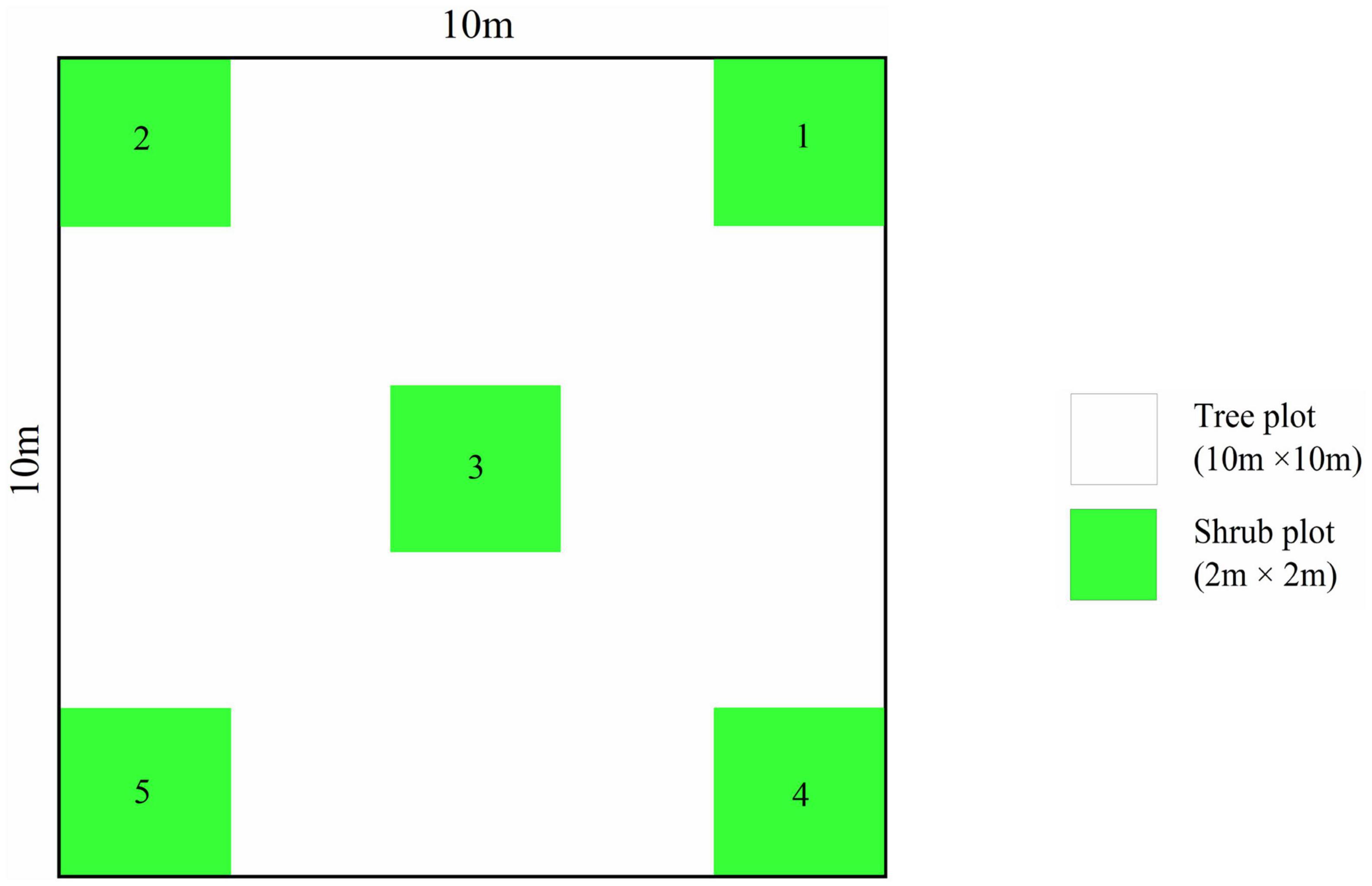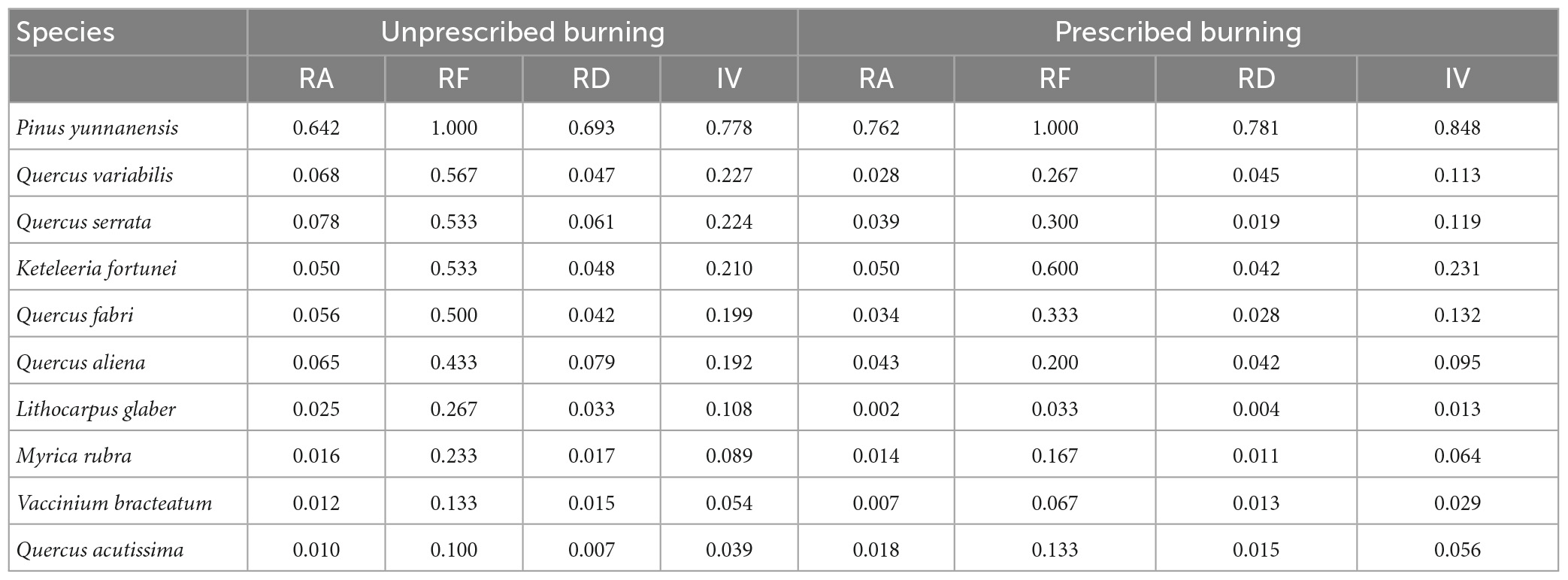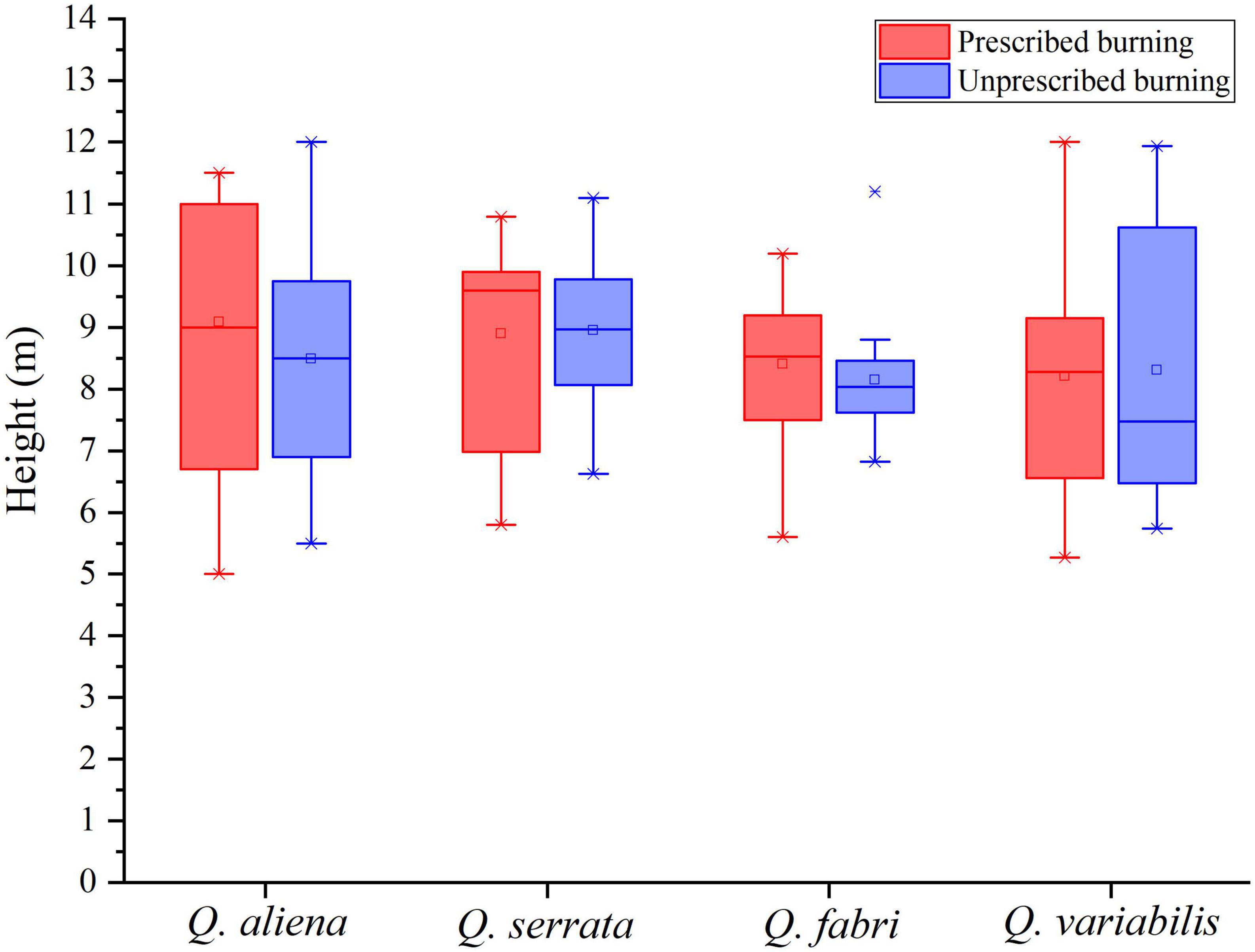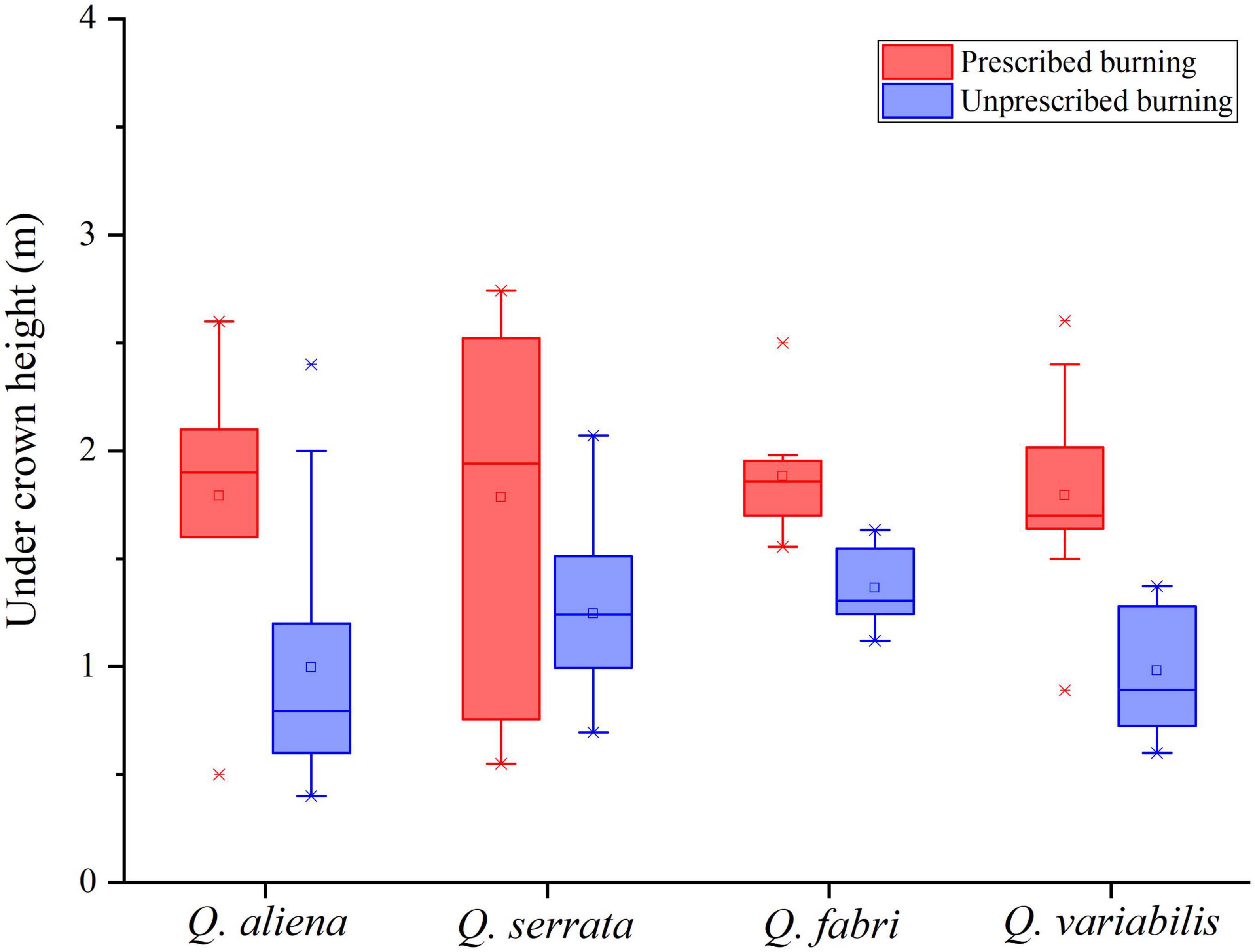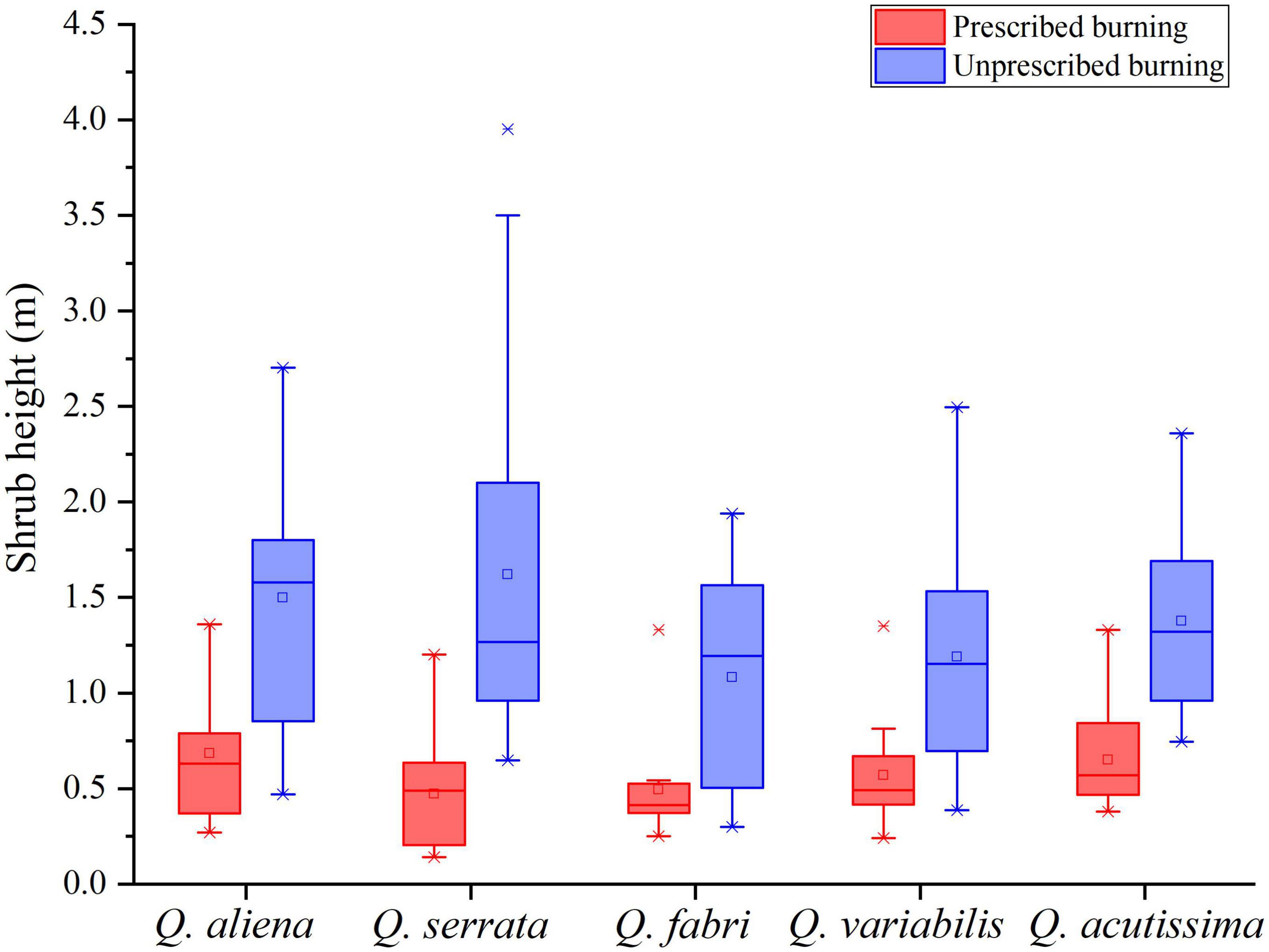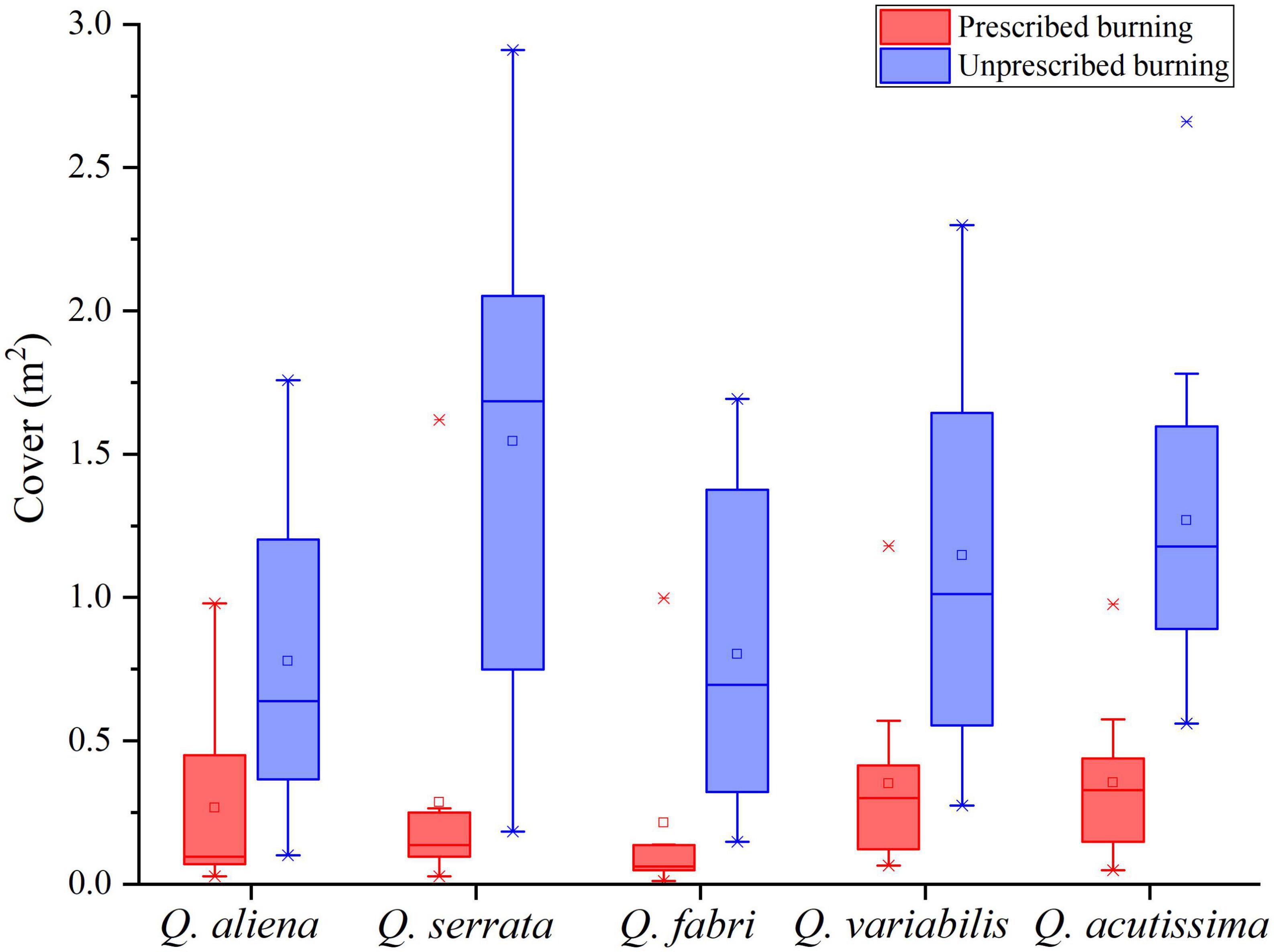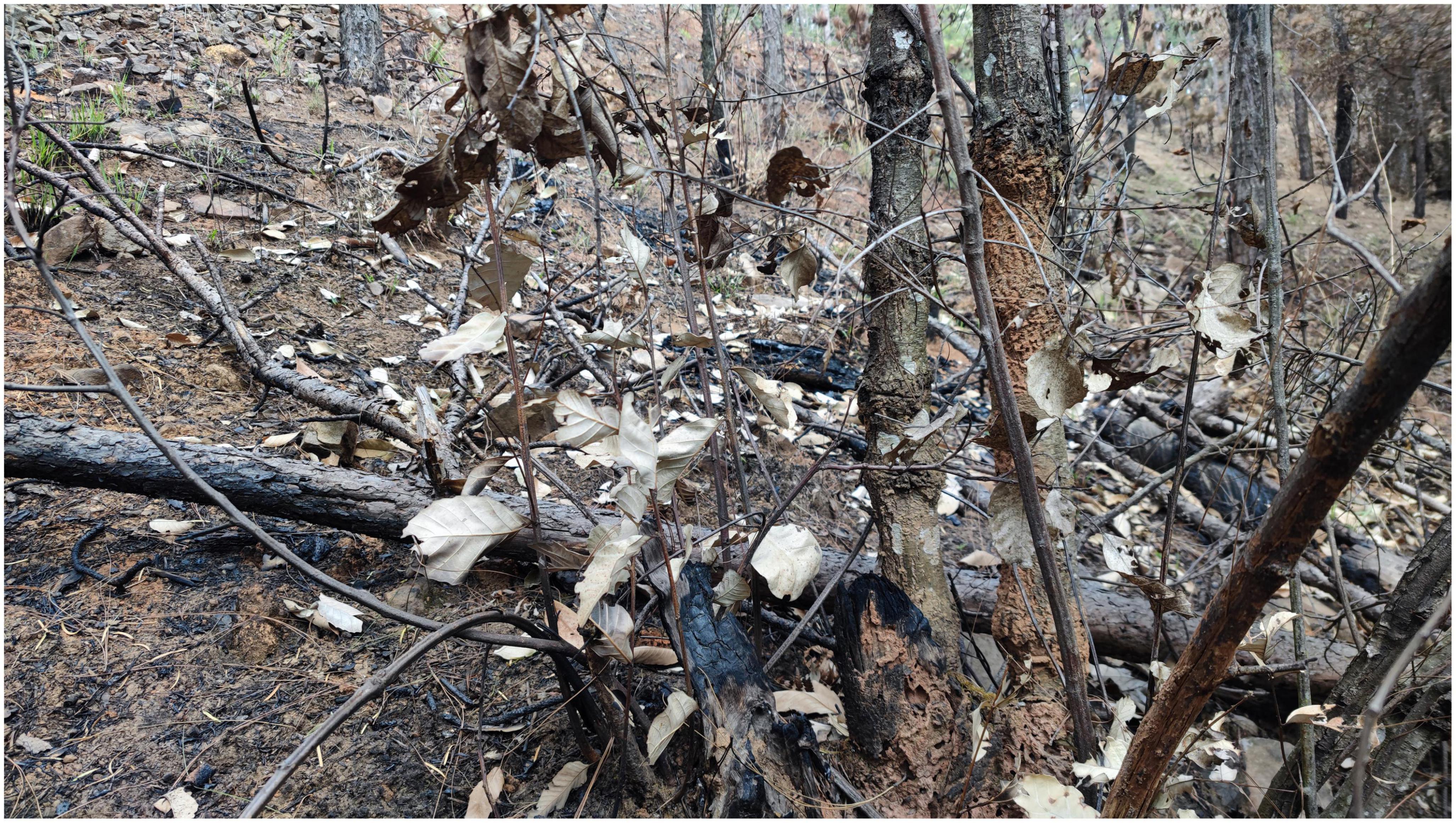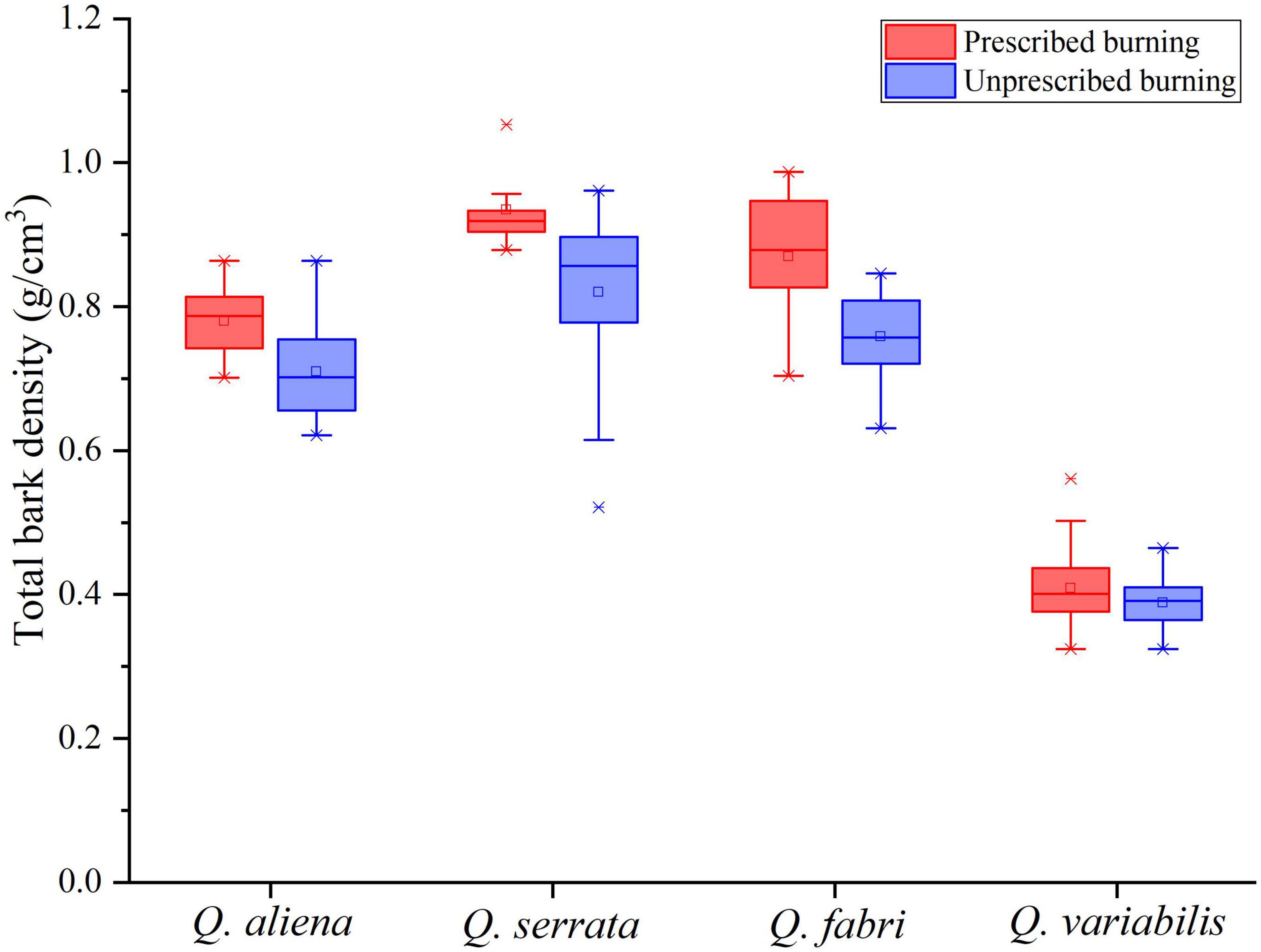- 1College of Civil Engineering, Southwest Forestry University, Yunnan Key Laboratory of Forest Disaster Warning and Control, Kunming, China
- 2College of Geography and Ecotourism, Southwest Forestry University, Kunming, China
- 3College of Big Data and Artificial Intelligence, Southwest Forestry University, Kunming, China
Introduction: Positioning studies on prescribed burning in Pinus yunnanensis forests have been conducted for several years, focusing on the effects of fire on the composition and structure, growth, regeneration, relative bark thickness, and bark density of understory oak species in Pinus yunnanensis forests.
Methods: The study was conducted on Zhaobi Mountain, Yi-Dai Autonomous County of Xinping, Yuxi City, Yunnan Province. In the prescribed burn after restoration of full 1 year of the area and did not implement the prescribed burn area were set up 10 m × 10 m sample plots 30 pairs of comparisons, and all the oak trees in the sample plots were recorded, each sample plot in the four apexes and the middle were set up five 2 m × 2 m small sample squares, the shrubs in the small sample squares for each plant survey, comparison, statistics and analysis of all data.
Results: The study results showed that (1) prescribed burning significantly affected the species composition of the understorey of Pinus yunnanensis forests. In both tree and shrub layers, the important values of Quercus aliena, Quercus serrata, Quercus fabri, and Quercus variabilis were significantly reduced in the burned areas. In contrast, the important values of Quercus acutissima increased somewhat. (2) The under crown height of oak trees in the burned areas was significantly lower than in the burned areas, but the height of oak trees in the burned areas was not significantly different from that in the burned areas. In the shrub layer, the height and cover of oak plants in the prescribed burning areas were significantly lower than in the unprescribed burned areas, effectively reducing the vertical continuity of the forest surface combustible material and reducing the possibility of fire converting from surface to canopy fire along the “ladder fuel.” (3) The regeneration of oak plants in the burned area is mainly by sprout tillers, and very few young sprouts are regenerated by seed germination. Renewed young sprouts are difficult to survive the prescribed burn areas the following year due to their lack of fire tolerance. (4) The relative bark thickness and density of oak plants in prescribed burn areas were significantly higher than those in unprescribed burn areas due to the fire tolerance exhibited by oak plants in long-term prescribed burns.
Discussion: Prescribed burning has profoundly altered the structural composition and growth of oak plants in the understory of Pinus yunnanensis forests, and oak plants have shown significant fire-adapted traits to resist fire under long-term fire disturbance. The study can provide a scientific basis for prescribed burning, forest fuels, and forest fire management.
Introduction
Fire has historically shaped China’s ecosystems’ structure, composition, and function (Hu et al., 2017; Wu et al., 2019; Gao et al., 2021). With economic and social growth, forest fires have become increasingly prominent (Guo et al., 2017). To effectively consume combustible material in forests and reduce forest fire risk, prescribed burns are now widely used in China to achieve specific forest management objectives. Prescribed burning is the purposeful, planned, and systematic application of fire to combustible material under the forest canopy in a defined area under human control to achieve the intended fire purpose (Trent et al., 2011). Prescribed burning can regulate a load of combustible material in forests (Fernandes, 2015; Penman et al., 2020) and effectively reduce the severity of forest fires (Finney et al., 2005), and has also been proposed for the management of grasslands (Orsolya et al., 2014; Policelli et al., 2019). Prescribed burning can improve plant resistance to pests and diseases (Hood et al., 2016), is an important forestry practice to promote tree growth (Mitchell et al., 2006), and provides an important way to manage forest ecosystems under suitable conditions (Van Lear et al., 2005). The impacts of prescribed burning on ecosystems and climate are complex and carry risks (Altangerel and Kull, 2013). Numerous experts and scholars have focused on the ecological impacts of prescribed burning, including effects on air pollutants (Sullivan et al., 2014; Liu et al., 2017), the environment (Burrows and Mccaw, 2013; Fernandes et al., 2013), microorganisms in the soil (Hannu et al., 1993; Oliver et al., 2015), effects on biodiversity (Altangerel and Kull, 2013; Durigan et al., 2020), effects on hydrology (Holden et al., 2015) and studies on the structure of understorey species (Burrows et al., 1989; Peterson and Reich, 2008; Potts and Stephens, 2009).
Some scholars have focused on the effects of long-term prescribed burns on species composition and structure in oak forests (Brose and Van Lear, 1999; Blake and Schuette, 2000; Burton et al., 2011; Hutchinson et al., 2012a). The majority of these studies have focused on oak forests in North America. Studies have shown that long-term repeated burning reduces the density of oak plants to some extent and causes some reduction in the cover of oak stands. The high frequency of prescribed burn removals had a significant impact on smaller diameter at breast height (DBH) oak plants, with all plants less than 11 cm DBH removed in the annual repeated burn study area in Missouri (Knapp et al., 2015). Studies of oak trees within the LBL National Recreation Area, Kentucky and Tennessee showed that for mature stands, prescribed burning had little effect because the trees were somewhat fire resistant prescribed burning reduces the density of young trees, but when combined with suitable thinning, the density may increase, for example, for oak trees less than 3.8 cm in DBH, the density increases after prescribed burning with suitable thinning (Franklin et al., 2003).
Oak plants are more fire-adapted than other common plants because of their vigorous germination capacity and are adapted to relatively dry conditions (Brose et al., 2013). Burning positively affects oak plant reproduction and regeneration, promoting pollination, increasing fruit set, facilitating germination, and promoting young sprout development (Arthur et al., 2012; Hutchinson et al., 2012b). After repeated fires, oak plants can germinate more quickly than other regenerating woody plants and gain a greater competitive advantage (Brose et al., 2013). However, high fire frequency and intensity can lead to reduced stand recovery due to the relative allocation of germination to seeding in oak species determined by the nature of fire disturbance, with fire-free periods too short to accumulate seed banks (Hutchinson et al., 2005). Shorter fire cycles may affect post-fire response by depleting the energy resources required for oak regeneration (Malkisnon et al., 2011).
Fire-adapted traits are developed due to plant performance being characterized in a fire-spatial environment, improving the ability of plants to survive fire disturbance (Keeley et al., 2011; Pausas, 2015a; He et al., 2016). Oak plants interact with fire factors and influence each other, gradually developing intrinsic physiological and external morphological responses and adaptive responses, mainly in the form of increased under crown height, thick bark, high wood density, rapid-fire scar resilience, and altered understorey apoplastic burnability (Romero et al., 2009; Varner et al., 2016). Tree species in fire-prone habitats, particularly those maintained by frequent low-intensity surface fires, have thicker bark than those in fire-prone habitats (Cavender-Bares et al., 2004; Poorter et al., 2014; Rosell et al., 2014; Pausas, 2015b). In most species with frequent fire habitat characteristics, bark thickness is a key factor in the survival of individual plants in the fire; the thicker the bark, the better the fire resistance of the species, and thick bark reduces the likelihood of fire damage to vascular formations and the sapwood (Michaletz and Johnson, 2007; Michaletz et al., 2012). The bark of oak species is usually thicker than that of other broad-leaved species distributed in the same growing area, specialized for a cork, such as the European cork oak (Quercus suber L.) (Touhami et al., 2020). Typically oak species with bark thicknesses greater than 3.4 cm provide good protection to the bast and formative layers of the trunk against thermal damage, and the tree is less likely to be killed by fire (Curt et al., 2009).
Unlike the study area in North America, China has a unique oak population, and there is still a need for more research on the effects of frequent prescribed burns on oak populations within forests where Pinus yunnanensis is the dominant species. As an important component of the understorey composition of Pinus yunnanensis forests, the Quercus species has a particular response pattern to long-term disturbance by low-intensity fire. This paper focuses on the species composition, growth, and regeneration of oak plants after prescribed burning and the adaptive physiological changes of oak plants to fire to investigate the effects of long-term prescribed burning on oak plants and to provide a reference for sustainable forest management.
Materials and methods
Study site and experimental design
The field survey of this study was conducted from February 2022 to March 2023. The study area is located in Yi-Dai Autonomous County of Xinping, Yuxi City, central Yunnan Province, 102°0′7′′∼102°0′8′′E, 24°2′38′′∼24°2′41′′N. The terrain is mainly plateau and mountainous, with a high northwest and low southeast topography. The Zhaobi Mountains are located in the north-south transition zone of the subtropical plateau monsoon region, with an average annual precipitation of 1050 mm, a maximum temperature of 32°C, a minimum temperature of 1°C and an average temperature of 15.1°C, and a main soil type is red soil. The region has a large area of Pinus yunnanensis forest, which has good habitat due to the excellent geographical conditions. The main oak species in the region are Quercus aliena var. acutiserrata Maximowicz ex Wenzig, Quercus serrata Murray, Quercus fabri Hance, Quercus variabilis Blume, and Quercus acutissima Carr.
The number of forest fires in Xinping County fluctuates greatly from year to year, with an average of 10 fires per year from 2001 to the present. The number of fires peaked in 2005 and 2012, with 34 fires in 2005 and 24 fires in 2012. Fires in Xinping County are highly seasonal, with fires mostly concentrated in winter and spring, when they are drier and more likely to occur. In addition, fires mainly occur near residential areas and fires are influenced by population activities.
The prescribed burns are low-intensity fires that reduce the combustible material (Figure 1). Because of the air pollution problems caused by the prescribed burn, the prescribed burn was suspended for 2 years in 2020 and 2021 and continued in 2022. The 2023 prescribed burn started with a small-scale burn on February 8 and continued until February 19, with the remaining prescribed burn area being burned on a large scale on February 20. By spreading the prescribed burn over a longer time, large-scale air pollution is effectively avoided.
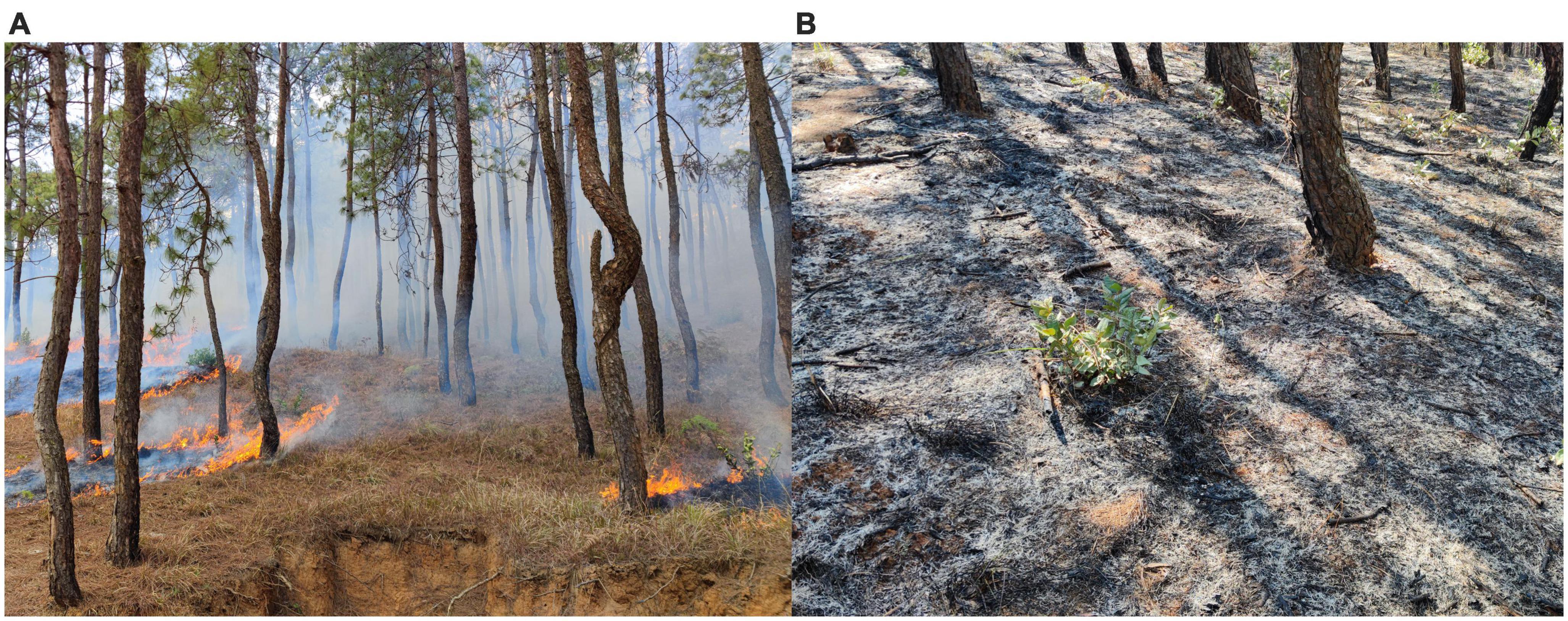
Figure 1. Photos of prescribed burning in Pinus yunnanensis forest. (A) Prescribed burning, and (B) forest after the fire.
Comparison of prescribed and unprescribed burn areas (Figure 2), where a dense shrub and herb layer is evident in the unprescribed burn areas. In this study, 30 randomly selected sample plots were established where prescribed burns were carried out, and 30 randomly selected sample plots were selected as control plots in controlled burn areas where prescribed burns had never been carried out (Figure 3). To avoid the influence of altitude, slope direction, and light on the experimental results, the altitude of both the experimental and control plots was within the range of 2000–2100 m, and the slope direction was consistently southwest, with the slope position being uphill.
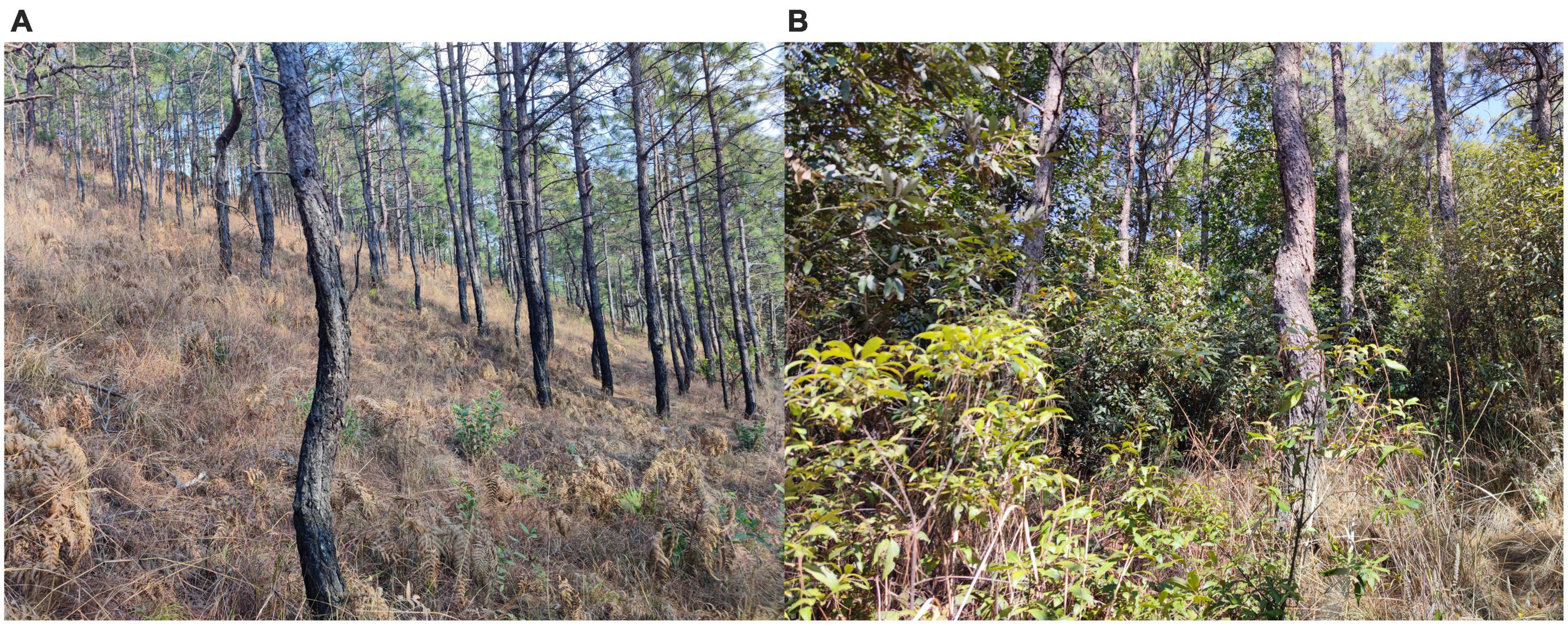
Figure 2. Photos to contrast the stand structure of panel (A) the prescribed burning area, and (B) the unprescribed burning area.
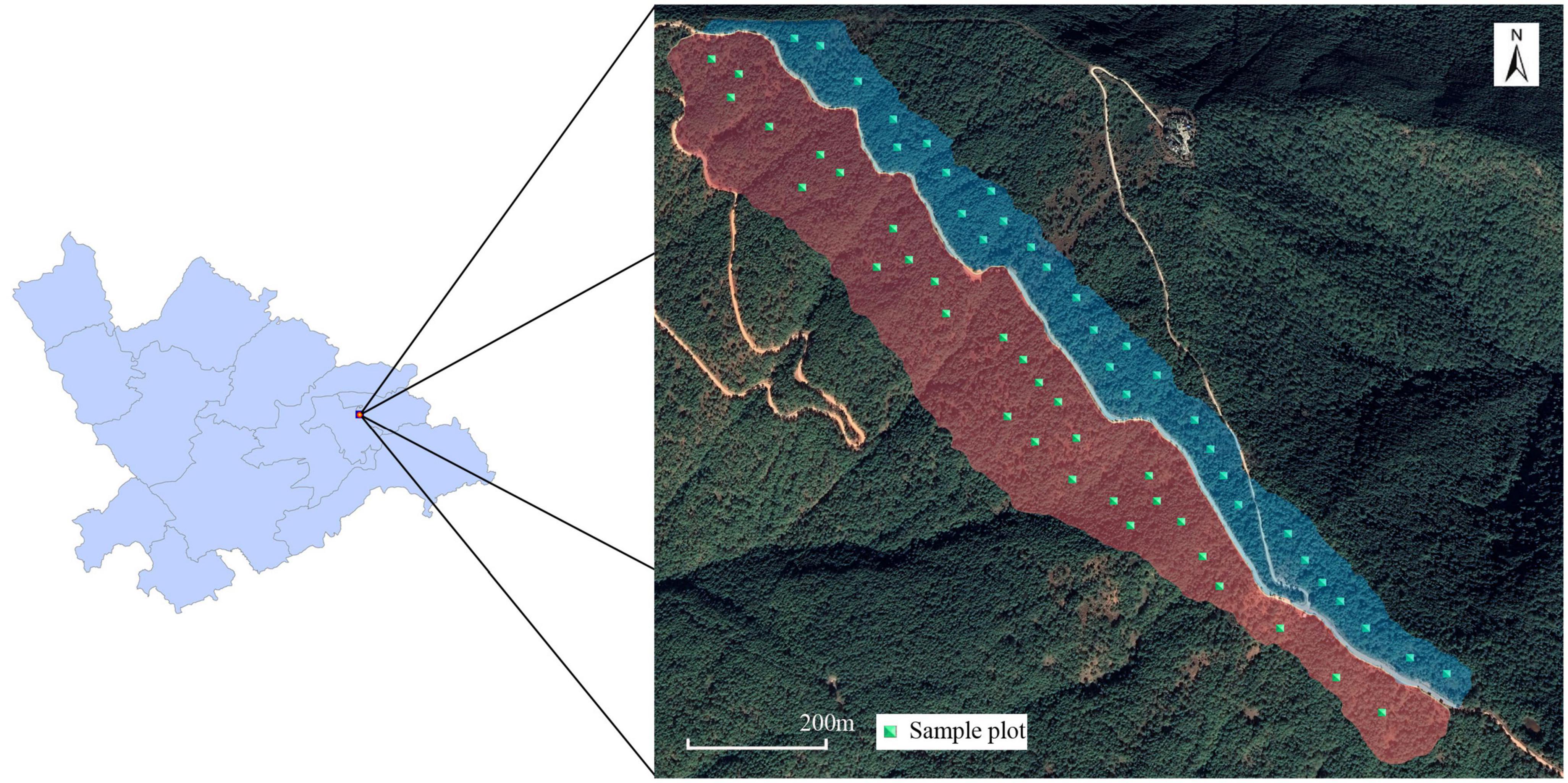
Figure 3. Pictures of the location of the study site, Zhaobi Mountain, in Xinping County. The situation of the study area and the distribution of the sample plots on Zhaobi Mountain were marked. Red is the study area for prescribed burning, blue is the study area for unprescribed burning.
The survey plots were each 10 m × 10 m in size, with five 2 m × 2 m plots for the shrub survey (Figure 4). Five plots were located at the four comers of the survey plots and in the middle of the survey plots, and the plots were numbered 1–5 in sequence. Each sample was numbered, and slope, canopy cover, altitude, latitude, and longitude were recorded. Those ≥1 m tall and <10 cm DBH were treated as shrubs during sampling (Knapp et al., 2015). Trees in the sample plots were surveyed per tree, with a diameter at the under crown height, DBH, and height measured and recorded. The shrubs in each small sample were recorded, and their height and cover were measured. The sprouting pattern of oak young sprouts less than 1.5 m in height was additionally recorded. The mortality of oak plant young sprouts was recorded after prescribed burnout.
Data processing
Calculation of important values
To explore the position and role of oak plants in the community, the important value index was calculated to explore changes in species composition and structure before and after the prescribed burn.
Important Value (IV):
Relative Abundance (RA):
Relative Frequency (RF):
Relative Dominance (RD):
(trees)
(shrubs)
Bark thickness and density
To investigate whether the bark thickness and density of oak plants are altered by successive years of prescribed burning, the relative bark thickness and density of oak trees were measured to investigate the response of oak bark to successive low-intensity fires.
Bark thickness measurement
The total bark thickness was measured at three heights (50, 100, and 150 cm) for oak trees over 5 m tall in the survey sample. To avoid serious tree damage during bark extraction, the bark was extracted to a controlled area of 5 × 2 cm 2 without damaging the xylem. Measurements were taken on a randomly selected trunk side, and each piece of bark was extracted with a hammer and chisel. Using vernier calipers, total bark thickness was measured at equally spaced intervals on each sample. Relative bark thicknesses were calculated for the study to compare differences in bark thickness between trees of different diameters (Graves et al., 2014).
Bark density measurement
Bark density was measured using a high-precision densitometer. To avoid errors in the measurements due to water loss or decomposition of the bark, the high-precision densitometer was transported by car to the vicinity of the study area, and the bark density measurements were carried out within 1 h of the completion of the sampling.
Statistical method
In this paper, we used analysis of variance (ANOVA) to compare the differences in tree height in the tree layer, under crown height, height in the shrub layer, shrub layer cover, relative total bark thickness, and total bark density of oak plants in the prescribed burned area with those in the unprescribed burned area. Statistical significance can be established when the probability of a Type-I error is less than 0.05. p < 0.05 indicates significant differences, and p < 0.01 indicates significantly greater differences.
Results
The impact of species composition of oak plants
A total of five oak species were found to be present in the study area, namely Quercus aliena, Quercus serrata, Quercus fabri, Quercus variabilis, and Quercus acutissima. Each species is found in prescribed and unprescribed burn areas, but the distribution patterns differ. As species distribution in the tree and shrub layers is distinct, the distribution of plants within the tree and shrub layers is analyzed separately.
In the tree layer (Table 1), Pinus yunnanensis was the dominant species, with significantly higher important values than other species in both prescribed and unprescribed burned areas. The important values and relative abundance of Q. variabilis, Q. serrata, Q. fabri, and Q. aliena in the tree layer decreased significantly after prescribed burning, with important values decreasing by 0.114, 0.105, 0.067, and 0.76. The distribution of Q. variabilis, Q. serrata, Q. fabri, and Q. aliena in the tree layer was significantly reduced in the prescribed burned area.
Unlike other oak species, the relative multiplicity of Q. acutissima increased by 0.08, and the important value increased by 0.017 in the prescribed burn area, which is more adapted to survive in the prescribed burn area.
In the shrub layer (Table 2), oak plants showed a clear dominance, especially in the unprescribed burn area, where Q. serrata had the highest important value of all plants at 0.300. In contrast, Q. fabri, Q. variabilis, and Q. aliena also had important values of 0.263, 0.244, and 0.164, respectively. The important values for Q. serrata, Q. fabri, Q. variabilis, and Q. aliena were lower than those for unprescribed burning areas by 0.212, 0.187, 0.131, and 0.098.
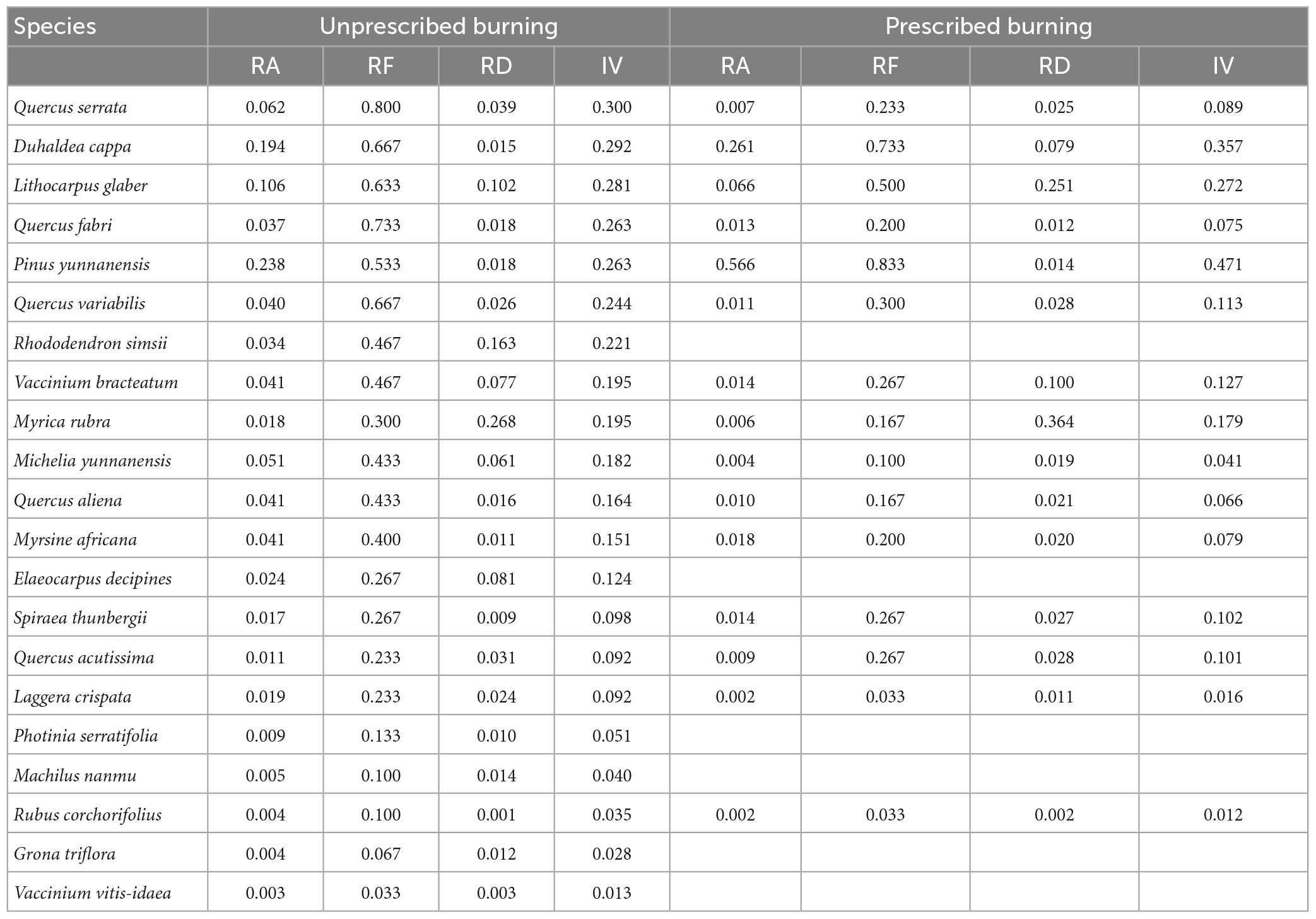
Table 2. Species composition of the shrub layer (no data available means this species was not found in the prescribed burning area).
In the area of prescribed burning, the Q. acutissima showed a trend toward increased dominance in the shrub layer, with an increase in important value of 0.009. This is the same trend the Q. acutissima showed toward greater survival dominance in the tree layer.
Growth of oak plants
Tree height and under crown height
Five Q. acutissima were found in the unprescribed burn area and eight in the prescribed burn area, too small a sample to be statistically significant. Therefore, the growth of Q. acutissima was not explored.
To study the effect of prescribed burning on the height of oak trees in the tree layer, the distribution of oak tree height in the prescribed burning sample plots and the control sample plots were counted (ANOVA: Q. aliena: F = 0.936, p = 0.34; Q. serrata: F = 0.002, p = 0.966; Q. fabri: F = 5.26, p = 0.427; Q. variabilis: F = 0.02, p = 0.899) (Figure 5). There were no significant differences in the height distribution of the various oak species, and prescribed burning did not significantly affect the height of oak trees at the tree level.
Statistics on under crown height distribution of oak in the tree layer in the prescribed burn and control sample plots (ANOVA: Q. aliena: F = 38.803, p < 0.001; Q. serrata: F = 12.379, p = 0.001; Q. fabri: F = 53.377, p < 0.001; Q. variabilis: F = 52.505, p < 0.001) (Figure 6). Prescribed burning had a highly significant effect on the under crown height of each oak species, with a substantial increase in mean under crown height. The mean under crown height of Q. aliena, Q. serrata, Q. fabri, and Q. variabilis was 0.928, 0.538, 0.519, and 0.814 m higher in the control area, respectively.
Shrub layer height and cover
The effect of prescribed burning on the height of oak plants in the shrub layer was studied. Statistics on the height distribution of oak plants in the prescribed burn and control sample plots (ANOVA: Q. aliena: F = 22.063, p < 0.001; Q. serrata: F = 20.63, p < 0.001; Q. fabri: F = 16.783, p < 0.001; Q. variabilis: F = 13.995, p < 0.001; Q. acutissima F = 17.474, p = 0.001) (Figure 7). Prescribed burn removal had a highly significant effect on the height distribution of each oak species, with the mean heights of Q. aliena, Q. serrata, Q. fabri, Q. variabilis, and Q. acutissima decreasing by 0.815, 1.149, 0.586, 0.62, and 0.725 m, respectively.
Statistics on the distribution of oak cover in the prescribed burn and control sample plots (ANOVA: Q. aliena: F = 12.593, p = 0.001; Q. serrata: F = 28.647, p < 0.001; Q. fabri: F = 17.964, p = 0.001; Q. variabilis: F = 22.167, p = 0.001; Q. acutissima: F = 19.941, p = 0.001) (Figure 8). Prescribed burning had a highly significant effect on the cover distribution of each oak species, with the mean height of Q. aliena, Q. serrata, Q. fabri, Q. variabilis, and Q. acutissima decreasing by 0.512,1.259,0.588, 0.797, and 0.916 m2 respectively. Prescribed burning reduced the mean height and cover of oak in the shrub layer, effectively disrupting the vertical continuity of forest combustibles and reducing the spread of forest fire from ground fire to canopy fire. The prescribed burning reduces the average height and cover of the shrub layer of oak, which effectively destroys the vertical continuity of combustible forest material and reduces the potential for forest fires to spread from ground fire to canopy fire.
The effect of prescribed burning on the regeneration patterns of oak plants
The renewal methods of oak young sprouts up to 150 cm in height in the study area were investigated. The renewal methods of oak plants were divided into sprout tillers and seed germination.
Different characteristics of oak young sprout regeneration in prescribed and unprescribed burned areas (Table 3). Oak in the burned area was mainly replaced by asexual regeneration through sprout tillers. The residual oak residues left after the prescribed burn provided the original nutrient accumulation for sprout tillers, and new plants were formed using shoots from the stumps and root systems left on the burned sites. Q. aliena and Q. fabri were not found to be renewed by seed germination in prescribed burning areas. Only one young sprout each of Q. serrata and Q. variabilis was found to be seed sprouting, and only two young sprouts of Q. acutissima were found to be seed sprouting in the study area. Young sprouts of oak plants were very rare in the prescribed burning areas.
The number of young shoots that germinated by seed was higher than the number of young shoots renewed by sprouting in all oak species in the unprescribed burn area. The cause of oak plant mortality in the unprescribed burn areas was usually disease or insect infestation, and these plants could usually re-sprout from the roots. However, the number of oak plants that died due to disease or insect infestation was only a minority of the total sample. The main method of oak plant regeneration in the unprescribed burn areas was still seed germination.
The survival of oak young sprouts after prescribed burning was investigated 1 month after the prescribed burn by revisiting the burned sites. All oak young sprouts under 50 cm in height died after the prescribed burn, only one Q. serrata and two Q. variabilis young sprouts survived in the 50–100 cm height range, only two Q. fabri young sprouts survived in the 100–150 cm height range, and one Q. aliena and one Q. acutissima each survived (Figure 9). Oak young sprouts lack resistance to prescribed burns, and young sprouts that resprout after the prescribed burn have difficulty surviving the burn the following year. The prescribed burn is scheduled for February and March each year when the seeds of oak plants have already fallen to the ground, and the burn will kill many fallen seeds. This will further reduce the ability of oak plants to regenerate.
Effect of prescribed burning on the bark of oak plants
Bark samples were taken from oak trees in the study plots at 50, 100, and 150 cm above ground level, and total bark thickness and total bark density were measured. Q. acutissima sample was too small to be statistically significant, so it was not explored.
Relative total bark thickness
The significance of the effect of prescribed burning on the relative total bark thickness of oak plants was investigated. The relative total bark thickness of oak plants in prescribed burn and control sample plots was ANOVA calculated (Table 4), and their distribution was counted (Figure 10). Relative bark thickness was significantly higher in prescribed burn areas than unprescribed burn areas, a trend evident at different heights for all four oak species. The mean relative bark thicknesses of Q. aliena, Q. serrata, Q. fabri, and Q. variabilis were 5.506, 2.975, 4.774, and 6.175, respectively, higher in the prescribed burned areas than in the unprescribed burned areas, and significantly higher at different heights in the prescribed burned areas than in the unprescribed burned areas.
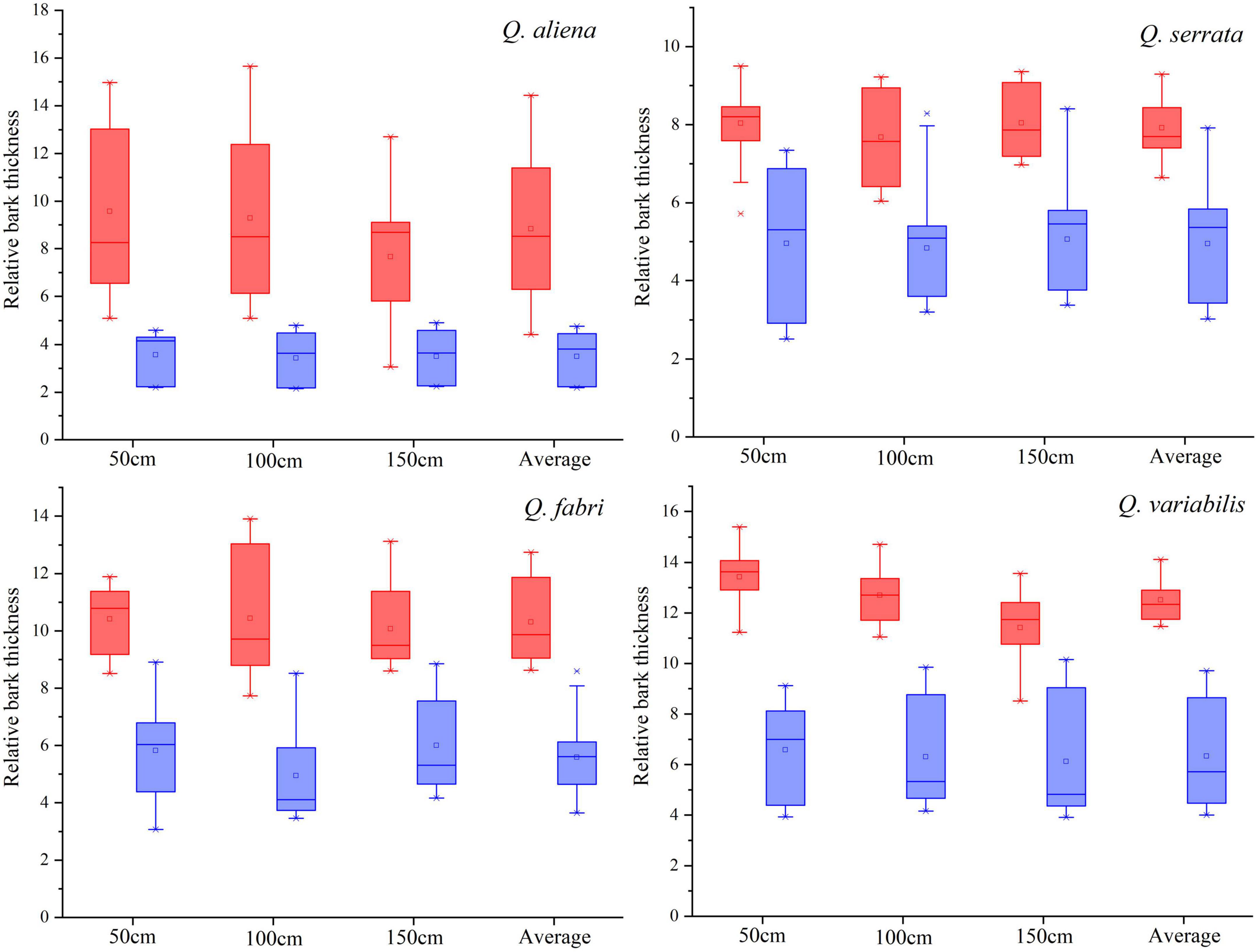
Figure 10. Relative total bark thickness at different heights. Red represents plants affected by prescribed burning; blue is plants unaffected by prescribed burning.
Total bark density
Bark density was measured by a high-precision densitometer and found that there was a tendency for the bark density of oak plants to increase in the planned burned areas compared to the unplanned burned areas. Statistics on the distribution of oak bark density in the prescribed burn and control sample plots (ANOVA: Q. aliena: F = 14.967, p < 0.001; Q. serrata: F = 16.946, p < 0.001; Q. fabri: F = 27.894, p < 0.001; Q. variabilis: F = 38.784, p < 0.001) (Figure 11). Prescribed burning had a highly significant effect on bark density. The mean bark densities of Q. aliena, Q. serrata, Q. fabri, and Q. variabilis increased by 0.075, 0.114, 0.111, and 0.828 g/cm3 after prescribed burning. The bark densities of oak plants were higher in prescribed burning areas than in unprescribed burning areas.
Discussion
Effect of prescribed burning on the distribution and growth status of oak plants
As a widely distributed species of oak in the understory of Pinus yunnanensis forests, the prescribed burn significantly reduced the importance and relative abundance of Q. aliena, Q. serrata, Q. fabri, and Q. variabilis in both tree and shrub layers. It significantly suppressed the oak distribution in the prescribed burn area.
The average tree height of oak plants in the tree layer in the prescribed burn areas did not change significantly, but the under crown height was significantly higher than in the unprescribed burn areas. The increase in under crown height indicates the adaptation of oak plants to successive years of prescribed burning. The increase in under crown height effectively reduced the impact of prescribed burning on oak plants. Within the shrub layer, the height and cover of oak plants were significantly lower in prescribed burn areas than in unprescribed burn areas, and the average height and cover of oak plants showed a significant decrease.
The distribution of oak plants, the dominant species in the understorey of Pinus yunnanensis forests, was suppressed after prescribed burning, and the average height and average cover of the shrub layer were reduced. From a forest fire prevention perspective, this reduces the vertical continuity of forest combustibles, reduces the likelihood of fire converting from surface fire to canopy fire along the “ladder fuel,” and achieves the objective of prescribed burning to prevent major forest fires.
Compared to other oak species, Q. acutissima is more suitable for survival in prescribed burn areas. The important values of Q. acutissima were higher in the prescribed burn areas than in the unprescribed burn areas in the tree and shrub layers. This may be because, in this study area, the competitive ability of Q. acutissima is low. After the prescribed burn, the abundance of other species decreases sharply, reducing the competitive pressure on Q. acutissima; therefore, Q. acutissima grows better in the prescribed burn. However, the effect of successive prescribed burns on Q. acutissima in areas where Q. acutissima is the dominant species needs further study.
Impact of prescribed burning on oak renewal methods
In the burned areas, oak plant regeneration was mainly by sprout tillers, with new plants sprouting from shoots on the rhizomes of plants that had survived the fire. In the unprescribed burn areas, significantly more oak plants were regenerated by seed germination than sprout tillers. There are few young sprouts of oak plants in the prescribed burn areas because the prescribed burn is scheduled for February and March each year when the seeds of oak plants have fallen to the ground. A large number of seeds die in the prescribed burn. Even if there are young sprouts that germinate successfully, it is very difficult for them to grow to fire resilient in the continuously prescribed burn environment. It is also difficult for sprouting young sprouts to survive repeated prescribed burns, and the ability of plant rhizomes to keep young shoots sprouting to sustain annual re-sprouting needs further study. The result is that oak plants are likely to age after a long period of prescribed burning, and the lack of new young stands to replenish them makes forest regeneration difficult. To ensure the regeneration of the forest, the time or interval between prescribed burns can be adjusted to some extent. Prescribed burns are carried out in February and March because it is relatively dry and the water content of fuel is low, making it easy for the understory to ignite. Whether prescribed burns can be carried out at other times requires further practice. For the prescribed burn interval, can be appropriate interval of a few years to stop the prescribed burn, when a new batch of oak young sprouts to establish a certain fire resistance, the prescribed burn again.
In unprescribed burn areas, oak plants are more often regenerated by seed germination, but some are still regenerated by rootstock germination. This part of the oak plant stem death is mainly due to pests or disease, but no oak plant death due to pests or disease was found in the prescribed burn area. It is assumed that prescribed burning has a suppressive effect on pests and diseases, but the suppressive effect will need to be discussed further in future studies.
Effect of prescribed burning on bark
In the area of prescribed burning, the relative thickness of the bark of all oak plants increased significantly, and the bark density also increased to different degrees depending on the oak species after being subjected to prescribed burning for a long time. The bark is an important tissue to protect the tree from fire disturbance. When subjected to low-intensity fires such as prescribed burns, the relative total bark thickness and bark density increase are self-protection mechanisms for oak plants. They are expressions of the adaptability of oak plants to fire.
Whether fire-adapted features can be retained after cessation of prescribed burnout
In prescribed burn areas, oak plants exhibit fire adaptations: increased under crown height, thicker bark, and increased bark density are among the traits. These traits allow oak plants to survive the low intensity of fire disturbance in prescribed burns each year. There are two speculations as to the reasons for these traits:
(I) Oak plants have developed these traits to adapt to fire disturbance;
(II) These traits do not arise from fire disturbance, but individuals that do not possess bark resistant to fire and disturbance are eliminated, and branches that are too short are killed by fire.
Further research is needed to address both of these speculations. This raises another question: whether fire-adapted traits in oak plants will be retained or even passed on to the next generation long after prescribed burning has ceased. If oak plants produce these traits to adapt to fire, then whether these fire-adapted traits will be retained or even inherited will require more long-term research.
Conclusion
This study was conducted in the Zhaobi Mountains, Xinping County, Yunnan Province, where prescribed burns have been carried out for several years. Unlike other areas, prescribed burns in this region are low-intensity fires with controlled fire regimes. This paper examines the response patterns of oak plants in the understory of Pinus yunnanensis forests after successive low-intensity fires. Conclusions were drawn by comparing oak plants’ structural composition, growth, regeneration, relative total bark thickness, and bark density in prescribed and unprescribed burned areas. The importance value and relative abundance of Q. aliena, Q. serrata, Q. fabri, and Q. variabilis in the burned areas were significantly lower than in the non-burned areas. The importance value and relative abundance of Q. acutissima were slightly higher than in the non-burned areas. The average height of oak trees in the tree layer was not significantly different between the burned and unburned areas. The mean height and cover of the shrub layer were significantly lower in the prescribed burned areas than in the unprescribed burned areas. These differences reflect the effectiveness of prescribed burning in reducing the load of fuel in the forest and reducing the vertical continuity of combustible material. This can effectively reduce fire risk levels in Yunnan. Prescribed burning areas are regenerated by oak plants mainly through sprout tillers, while very few oak plants are regenerated through seed germination. Renewed oak young sprouts have difficulty surviving prescribed burns the following year due to their lack of fire resistance. Under the influence of successive prescribed burns, oak plants show some fire-adapted characteristics. The average under crown height of oak plants was significantly higher in prescribed burn areas than unprescribed burn areas. The relative total bark thickness and bark density were significantly higher than in unprescribed burn areas. These traits help reduce damage to oak plants in prescribed burns, effectively reducing the thermal impact and giving them a competitive advantage. Overall, prescribed burning had a significant effect on suppressing the distribution of Quercus species, while under prolonged fire disturbance, Quercus species developed some adaptive capacity to fire.
Data availability statement
The original contributions presented in this study are included in the article/supplementary material, further inquiries can be directed to the corresponding author.
Author contributions
RH, JL, and QW contributed to the study conception and design. RH, JL, JW, XZ, XL, CM, HC, and QW performed the experiments. RH, JL, and LW contributed to the data analysis, interpretation of results, and draft manuscript preparation. QW revised and edited the manuscript. All authors contributed to the manuscript revision, read, and approved the submitted version.
Funding
This study was supported by the National Natural Science Foundation of China (Grant Numbers: 32160376 and 31960318), the Key Development and Promotion Project of Yunnan Province (Grant Number: 202202AD080010), and the Scientific Research Project of Yunnan Education Department (Grant Number: 2023Y0778).
Acknowledgments
We are grateful for the diligence in maintaining this study by Jun Pu, Wanhui Bai, and other Xinping Department of Conservation personnel, as well as the many individuals involved with the initiation and early phases of this study.
Conflict of interest
The authors declare that the research was conducted in the absence of any commercial or financial relationships that could be construed as a potential conflict of interest.
Publisher’s note
All claims expressed in this article are solely those of the authors and do not necessarily represent those of their affiliated organizations, or those of the publisher, the editors and the reviewers. Any product that may be evaluated in this article, or claim that may be made by its manufacturer, is not guaranteed or endorsed by the publisher.
References
Altangerel, K., and Kull, C. A. (2013). The prescribed burning debate in Australia: Conflicts and compatibilities. J. Environ. Plann. Manag. 56, 103–120. doi: 10.1080/09640568.2011.652831
Arthur, M. A., Alexander, H. D., Dey, D. C., Schweitzer, C. J., and Loftis, D. L. (2012). Refining the oak-fire hypothesis for management of oak-dominated forests of the eastern United States. J. For. 110, 257–266. doi: 10.5849/jof.11-080
Blake, J. G., and Schuette, B. (2000). Restoration of an oak forest in east-central Missouri: Early effects of prescribed burning on woody vegetation. For. Ecol. Manag. 139, 109–126. doi: 10.1016/S0378-1127(99)00338-2
Brose, P., and Van Lear, D. (1999). Effects of seasonal prescribed fires on residual overstory trees in oak-dominated shelterwood stands. South J. Appl. For. 23, 88–93. doi: 10.1093/sjaf/23.2.88
Brose, P. H., Dey, D. C., Phillips, R. J., and Waldrop, T. A. (2013). A meta-analysis of the fire-oak hypothesis: Does prescribed burning promote oak reproduction in eastern North America? For. Sci. 59, 322–334. doi: 10.5849/forsci.12-039
Burrows, N. D., Woods, Y. C., Ward, B. G., and Robinson, A. D. (1989). Prescribing low intensity fire to kill wildings in pinus radiata plantations in western australia. Aust. Forestry 52, 45–52. doi: 10.1080/00049158.1989.10674535
Burrows, N., and Mccaw, L. (2013). Prescribed burning in southwestern Australian forests. Front. Ecol. Environ. 11, e25–e34. doi: 10.1890/120356
Burton, J. A., Hallgren, S. W., Fuhlendorf, S. D., and Leslie, D. M. (2011). Understory response to varying fire frequencies after 20 years of prescribed burning in an upland oak forest. Plant Ecol. 212, 1513–1525. doi: 10.1007/s11258-011-9926-y
Cavender-Bares, J., Kitajima, K., and Bazzaz, F. A. (2004). Multiple trait associations in relation to habitat differentiation among 17 Floridian oak species. Ecol. Monogr. 74, 635–662. doi: 10.1890/03-4007
Curt, T., Adra, W., and Borgniet, L. (2009). Fire-driven oak regeneration in French mediterranean ecosystems. For. Ecol. Manag. 258, 2127–2135. doi: 10.1016/j.foreco.2009.08.010
Durigan, G., Pilon, N. A. L., Abreu, R. C. R., Hoffmann, W. A., Martins, M., Fiorillo, B. F., et al. (2020). No net loss of species diversity after prescribed fires in the Brazilian savanna. Front. For. Glob. Change 3:13. doi: 10.3389/ffgc.2020.00013
Fernandes, P. M. (2015). Empirical support for the use of prescribed burning as a fuel treatment. Curr. For. Rep. 1, 118–127. doi: 10.1007/s40725-015-0010-z
Fernandes, P. M., Davies, G. M., Ascoli, D., Fernandez, C., Moreira, F., Rigolot, E., et al. (2013). Prescribed burning in southern Europe: Developing fire management in a dynamic landscape. Front. Ecol. Environ. 11, e4–e14. doi: 10.1890/120298
Finney, M. A., McHugh, C. W., and Grenfell, I. C. (2005). Stand- and landscape-level effects of prescribed burning on two Arizona wildfires. Can. J. For. Res. 35, 1714–1722. doi: 10.1139/X05-090
Franklin, S. B., Robertson, P. A., and Fralish, J. S. (2003). Prescribed burning effects on upland Quercus forest structure and function. For. Ecol. Manag. 184, 315–335. doi: 10.1016/S0378-1127(03)00153-1
Gao, C., Wang, G., Santin, C., Doerr, S. H., Cong, J., and Zhao, H. (2021). Response of Calamagrostis angustifolia to burn frequency and seasonality in the Sanjiang Plain wetlands (Northeast China). J. Environ. Manag. 300:113759. doi: 10.1016/j.jenvman.2021.113759
Graves, S. J., Rifai, S. W., and Putz, F. E. (2014). Outer bark thickness decreases more with height on stems of fire-resistant than fire-sensitive Floridian oaks (Quercus spp.; Fagaceae). Am. J. Bot. 101, 2183–2188. doi: 10.3732/ajb.1400412
Guo, F., Su, Z., Wang, G., Sun, L., Tigabu, M., Yang, X., et al. (2017). Understanding fire drivers and relative impacts in different Chinese forest ecosystems. Sci. Total Environ. 605, 411–425. doi: 10.1016/j.scitotenv.2017.06.219
Hannu, F., Taina, P., and Janna, P. (1993). Recovery of soil microbial biomass and activity from prescribed burning. Can. J. For. Res. 23, 1286–1290. doi: 10.1139/x93-164
He, T., Belcher, C. M., Lamont, B. B., and Lim, S. L. (2016). A 350-million-year legacy of fire adaptation among conifers. J. Ecol. 104, 352–363. doi: 10.1111/1365-2745.12513
Holden, J., Palmer, S. M., Johnston, K., Wearing, C., Irvine, B., and Brown, L. E. (2015). Impact of prescribed burning on blanket peat hydrology. Water Resour. Res. 51, 6472–6484. doi: 10.1002/2014WR016782
Hood, S. M., Baker, S., and Sala, A. (2016). Fortifying the forest: Thinning and burning increase resistance to a bark beetle outbreak and promote forest resilience. Ecol. Appl. 26, 1984–2000. doi: 10.1002/eap.1363
Hu, T., Sun, L., Hu, H., and Guo, F. (2017). Effects of fire disturbance on soil respiration in the non-growing season in a Larix Gmelinii forest in the Daxing’an mountains, China. PLoS One 12:e0180214. doi: 10.1371/journal.pone.0180214
Hutchinson, T. F., Long, R. P., Rebbeck, J., Sutherland, E. K., and Yaussy, D. A. (2012b). Repeated prescribed fires alter gap-phase regeneration in mixed-oak forests. Can. J. For. Res. 42, 303–314. doi: 10.1139/x11-184
Hutchinson, T. F., Sutherland, E. K., and Yaussy, D. A. (2005). Effects of repeated prescribed fires on the structure, composition, and regeneration of mixed-oak forests in Ohio. For. Ecol. Manag. 218, 210–228. doi: 10.1016/j.foreco.2005.07.011
Hutchinson, T. F., Yaussy, D. A., Long, R. P., Rebbeck, J., and Sutherland, E. K. (2012a). Long-term (13-year) effects of repeated prescribed fires on stand structure and tree regeneration in mixed-oak forests. For. Ecol. Manag. 286, 87–100. doi: 10.1016/j.foreco.2012.08.036
Keeley, J. E., Pausas, J. G., Rundel, P. W., Bond, W. J., and Bradstock, R. A. (2011). Fire as an evolutionary pressure shaping plant traits. Trends Plant Sci. 16, 406–411. doi: 10.1016/j.tplants.2011.04.002
Knapp, B. O., Stephan, K., and Hubbart, J. A. (2015). Structure and composition of an oak-hickory forest after over 60 years of repeated prescribed burning in Missouri, U.S.A. For. Ecol. Manag. 344, 95–109. doi: 10.1016/j.foreco.2015.02.009
Liu, X., Huey, L. G., Yokelson, R. J., Selimovic, V., Simpson, I. J., Müller, M., et al. (2017). Airborne measurements of western US wildfire emissions: Comparison with prescribed burning and air quality implications. J. Geophys. Res. Atmos. 122, 6108–6129. doi: 10.1002/2016JD026315
Malkisnon, D., Wittenberg, L., Beer, O., and Barzilai, R. (2011). Effects of repeated fires on the structure, composition, and dynamics of mediterranean maquis: Short- and long-term perspectives. Ecosystems 14, 478–488. doi: 10.1007/s10021-011-9424-z
Michaletz, S. T., and Johnson, E. A. (2007). How forest fires kill trees: A review of the fundamental biophysical processes. Scand. J. For. Res. 22, 500–515. doi: 10.1080/02827580701803544
Michaletz, S. T., Johnson, E. A., and Tyree, M. T. (2012). Moving beyond the cambium necrosis hypothesis of post-fire tree mortality: Cavitation and deformation of xylem in forest trees. New Phytol. 194, 254–263. doi: 10.1111/j.1469-8137.2011.04021.x
Mitchell, R. J., Hiers, J. K., O’Brien, J. J., Jack, S. B., and Engstrom, R. T. (2006). Silviculture that sustains: The nexus between silviculture, frequent prescribed fire, and conservation of biodiversity in longleaf pine forests of the southeastern United States. Can. J. For. Res. 36, 2724–2736. doi: 10.1139/X06-100
Oliver, A. K., Callaham, M. A., and Jumpponen, A. (2015). Soil fungal communities respond compositionally to recurring frequent prescribed burning in a managed southeastern US forest ecosystem. For. Ecol. Manag. 345, 1–9. doi: 10.1016/j.foreco.2015.02.020
Orsolya, V., Péter, T., Balázs, D., and Béla, T. (2014). Review: Prospects and limitations of prescribed burning as a management tool in European grasslands. Basic Appl. Ecol. 15, 26–33. doi: 10.1016/j.baae.2013.11.002
Pausas, J. G. (2015a). Evolutionary fire ecology: Lessons learned from pines. Trends Plant Sci. 20, 318–324. doi: 10.1016/j.tplants.2015.03.001
Pausas, J. G. (2015b). Bark thickness and fire regime. Funct. Ecol. 29, 315–327. doi: 10.1111/1365-2435.12372
Penman, T. D., Clarke, H., Cirulis, B., Boer, M. M., Price, O. F., and Bradstock, R. A. (2020). Cost-effective prescribed burning solutions vary between landscapes in Eastern Australia. Front. For. Glob. Change 3:79. doi: 10.3389/ffgc.2020.00079
Peterson, D., and Reich, P. (2008). Fire frequency and tree canopy structure influence plant species diversity in a forest-grassland ecotone. Plant Ecol. 194, 5–16. doi: 10.1007/s11258-007-9270-4
Policelli, N., Picca, P., and Villafañe, I. G. (2019). Is prescribed fire a suitable management tool to reduce shrub encroachment in palm savannas?: Prescribed fire in palm savannas. Restor. Ecol. 27, 109–119. doi: 10.1111/rec.12824
Poorter, L., McNeil, A., Hurtado, V., Prins, H. H. T., and Putz, F. E. (2014). Bark traits and life-history strategies of tropical dry- and moist forest trees. Funct. Ecol. 28, 232–242. doi: 10.1111/1365-2435.12158
Potts, J. B., and Stephens, S. L. (2009). Invasive and native plant responses to shrubland fuel reduction: Comparing prescribed fire, mastication, and treatment season. Biol. Conserv. 142, 1657–1664. doi: 10.1016/j.biocon.2009.03.001
Romero, C., Bolker, B. M., and Edwards, C. E. (2009). Stem responses to damage: The evolutionary ecology of Quercus species in contrasting fire regimes. New Phytol. 182, 261–271. doi: 10.1111/j.1469-8137.2008.02733.x
Rosell, J. A., Gleason, S., Méndez-Alonzo, R., Chang, Y., and Westoby, M. (2014). Bark functional ecology: Evidence for tradeoffs, functional coordination, and environment producing bark diversity. New Phytol. 201, 486–497. doi: 10.1111/nph.12541
Sullivan, A. P., May, A. A., Lee, T., McMeeking, G. R., Kreidenweis, S. M., Akagiamy, S. K., et al. (2014). Airborne characterization of smoke marker ratios from prescribed burning. Atmos. Chem. Phys. 14, 10535–10545. doi: 10.5194/acp-14-10535-2014
Touhami, I., Chirino, E., Aouinti, H., Khorchani, A. E., Elaieb, M. T., and Khaldi, A. (2020). Decline and dieback of cork oak (Quercus suber L.) forests in the Mediterranean basin: A case study of Kroumirie, Northwest Tunisia. J. For. Res. 31, 1461–1477.
Trent, D. P., Fiona, J. C., Alan, N. A., Ross, A. B., Geoffrey, J. C., Meredith, K. H., et al. (2011). Prescribed burning: How can it work to conserve the things we value? Int. J. Wildland Fire 20, 721–733. doi: 10.1071/WF09131
Van Lear, D. H., Carroll, W. D., Kapeluck, P. R., and Johnson, R. (2005). History and restoration of the longleaf pine-grassland ecosystem: Implications for species at risk. For. Ecol. Manag. 211, 150–165. doi: 10.1016/j.foreco.2005.02.014
Varner, J. M., Kane, J. M., Hiers, J. K., Kreye, J. K., and Veldman, J. W. (2016). Suites of fire-adapted traits of Oaks in the Southeastern USA: Multiple strategies for persistence. Fire Ecol. 12, 48–64. doi: 10.4996/fireecology.1202048
Keywords: Quercus, species composition, growth condition, regeneration methods, bark, Pinus yunnanensis forest, prescribed burning
Citation: Hong R, Li J, Wang J, Zhu X, Li X, Ma C, Cao H, Wang L and Wang Q (2023) Effects of prescribed burning on understory Quercus species of Pinus yunnanensis forest. Front. For. Glob. Change 6:1208682. doi: 10.3389/ffgc.2023.1208682
Received: 19 April 2023; Accepted: 15 May 2023;
Published: 22 June 2023.
Edited by:
Tongxin Hu, Northeast Forestry University, ChinaReviewed by:
Meng Guo, Northeast Normal University, ChinaZhang Heng, Inner Mongolia Agricultural University, China
Copyright © 2023 Hong, Li, Wang, Zhu, Li, Ma, Cao, Wang and Wang. This is an open-access article distributed under the terms of the Creative Commons Attribution License (CC BY). The use, distribution or reproduction in other forums is permitted, provided the original author(s) and the copyright owner(s) are credited and that the original publication in this journal is cited, in accordance with accepted academic practice. No use, distribution or reproduction is permitted which does not comply with these terms.
*Correspondence: Qiuhua Wang, cWh3YW5nMjAxMEBzd2Z1LmVkdS5jbg==
 Ruicheng Hong
Ruicheng Hong Jialin Li1
Jialin Li1 Xiaona Li
Xiaona Li